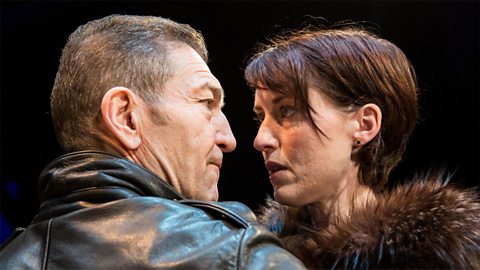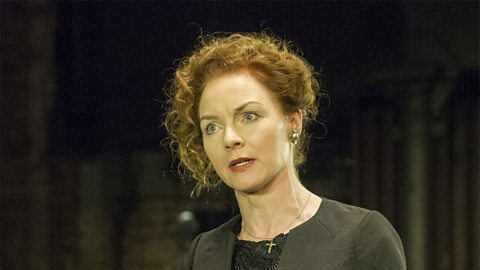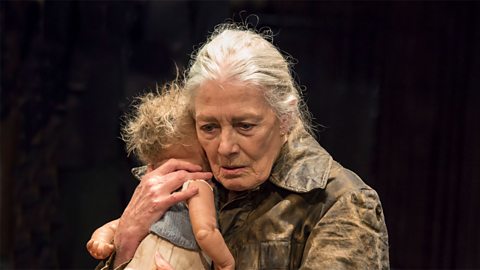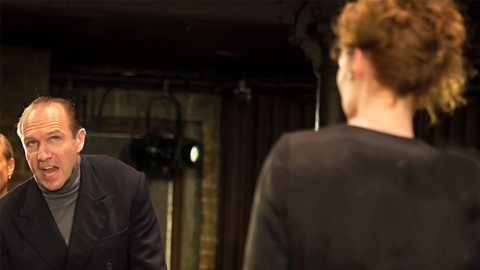Key points
Richard III is a history play by William Shakespeare that tells the story of Richard, the Duke of Gloucester, who murders and plots to become king of England.
Themes are the main ideas that appear repeatedly in a play. Some of the important themes in Richard III are:
Leadership – the play explores different types of leadership, from Richard’s corrupt king to Richmond’s moral role.
Family and blood ties – the play deals with loyalty and betrayals within families, fuelled by the Wars of the Roses.
Fate – the idea that life’s journey is already mapped out, and that this journey cannot be changed.
Did you know?
Shakespeare often uses similar themes across his plays. For example:
The themes of fate and family are important in Romeo and Juliet.
The play Macbeth deals with ambition and the desire for leadership.
Leadership
Watch this video about leadership in Richard III:
Narrator: Leadership. Some things suit us, other things don’t. Here’s Richard, trying on a peaceful little number. He doesn’t like it. He misses the old days of constant warfare and battle. He’s calling over the shop assistant. Maybe something a little more ‘armoury?’ No. It’s the bloodstains that he likes. Yes, that and the treachery and murder. That’s definitely him.
Edward IV has had enough of war. He wants everyone to be friends. Sounds like a proper leader, it’s a shame he dies. No. That doesn’t suit him, does it? To pull that off you’ll need leadership qualities: such as honour and a respect for life and justice. Maybe he’ll start being a good leader? But no. It’s his usual style.
Ah. Here comes Richmond. He says the crown suits him better. He says it matches his love of peace, justice and mercy. Oh. Bit of violence in the changing rooms. Must be the January sales. Glad Richmond won. In this play Shakespeare shows us that the best leaders love peace and loyalty. Not war and treachery. So, Richmond, what’s your first…oh, I was enjoying that.
Richard gains power through deception, fear and crime. Because he has used corruption to achieve leadership, he starts to lose control as he loses power. Shakespeare shows that true leadership must be just and inspire loyalty.
King Edward IV is shown to be a moral leader. Before his death, he tries to solve the conflicts in the royal court and establish harmony. In contrast to Richard, he thinks of the greater good rather than his own power.
Richmond’s private prayers show that he has good intentions as the future king and faces his responsibility bravely for the sake of his country. His reasons for overthrowTo use force to remove someone or something from power. Richard are unselfish and just. Richmond also proves himself to be a strong leader by giving rousing speeches to his men before the battle.
What were the Wars of the Roses?
The Wars of the Roses were a series of feuds in the 1400s between two branches of the royal family who were fighting each other for the English throne. It was called the Wars of the Roses because each branch of the family had a rose as its symbol – the House of York had a white rose and the House of Lancaster had a red rose.
Family and blood ties
Watch this video about family and blood ties in Richard III:
Narrator: Family and blood ties. You’re not just looking at a family tree here, you’re looking at a family business. The House of York. Their business? Ruling England. Eldest males are in charge that’s why the Duchess of York isn’t. So, that makes Edward king.
What if you want promotion in the family? Richard does. It doesn’t matter that his brothers stand in the way. Family means nothing to him. First of all, Richard gets rid of Clarence. Then, his eldest brother, Edward, dies. Saves Richard the trouble. Richard becomes king.
What about them? The princes. They could be king one day. Richard won’t let that happen, so he kills them too. So, who’s left? He could marry his sister-in-law, but she’s a bit too old. He even suggests marrying her daughter instead. Yes, that’s right. His niece.
His mother is so disgusted by him, she curses him! Shakespeare’s Richard III is horrible! Absolutely vile! His crimes are made all the more worse because he destroys those that loved him the most: his own family.
Don’t worry. The real historical Richard III wasn’t as bad as that. Shakespeare wrote this play to flatter the Tudors. Henry VII is up next. And his son is that lovely, lovely family man, Henry VIII… oh dear.
Blood ties
Richard shows no loyalty to his family and disregards any blood ties. Richard’s brother Clarence believes his brother is loyal and does not realise that Richard has organised his imprisonment and murder.
Before he dies, Edward IV makes Richard Lord Protector because he trusts his brother. Lord Protector is a powerful role that is given to an adult member of the family when the heir to the throne is too young to rule. Richard abuses this role and uses his position of power to further betray his family.
Richard claims his nephews are illegitimateA child born to parents who are not lawfully married. to strengthen his own claim to the throne and weaken the young heirs’ position. After Richard has been made king, he has both his nephews murdered, the ultimate betrayal of his brother’s trust.

Women and marriage
Marriages are used to strengthen political positions in the play. Richard first marries Lady Anne and then has her killed when she is no longer useful to him. He then tries to marry his niece Princess Elizabeth. He thinks that marrying King Edward IV’s daughter will strengthen his position as king.
When women become widows in the play, they lose much of their influence and power. After King Edward IV dies, Queen Elizabeth is powerless to stop Richard murdering her brother and her sons. Richard’s own mother curses him for his actions and wishes she had strangled him at birth.

Fate
Watch this video about fate in Richard III:
Narrator: Fate. Fate is the idea that the future is already decided. If the future’s already planned out, could we have a sneaky peek at those future plans? In this play some characters seem to be able to have a sneaky peek in their dreams.
Clarence has a dream in which he’s pushed into the sea by his brother, Richard. It certainly spooks him. But he finds it hard to believe that his brother would want to kill him, so he ignores his dream. And that’s fair enough. I had a dream about being chased by fish fingers. You’d hardly expect me to pay attention to that.
But Clarence’s dream predicts the future. He gets murdered. And dumped into a watery grave. If he did pay attention, would it have changed anything? What about curses? Do you think a curse can change someone’s future?
Queen Margaret and the Duchess of York both curse Richard. Do you think the curse worked? I mean, what if your mum told you on the day of your driving test that you would fail, how do you think you’d do?
Shakespeare gives us a villain who ignores every rule, taboo and law there is. But he hints that there’s a supernatural law that can’t be cheated. Some people really can’t avoid their fate.
Shakespeare explores the theme of fate in Richard III and the idea that bad deeds lead to bad ends. The audience knows that Richard will be punished for his evil actions and he is fated to have an unhappy ending
Margaret’s curses
Margaret plays an important role in predicting the fate of the other characters. She curses many of the characters in the royal court and reminds them of their crimes during the Wars of the Roses. Many of her curses come true.
Dreams as warnings
When Clarence is in prison, he dreams that his brother stumbles and pushes him into the sea. His dream of drowning foreshadowA suggestion of something happening in the future. his murder, and he is soon stabbed on his brother’s orders and his body is dumped in vatA large container that usually holds liquid. of wine.
Richard and Richmond also have dreams before the final battle. Richard is cursed by the ghosts of all his victims and Richmond is blessed. Their fates are confirmed by the actions of the ghosts.
What do these lines reveal about the theme of fate?
O now let Richmond and Elizabeth,
The true succeeders of each royal house,
By God’s fair ordinance conjoin together!
– Richmond,
Richmond has defeated Richard and become the newly crowned King Henry VII. This quotation suggests that his ascension to the throne is all part of God’s plan – he was fated to become the next king of England. Richmond is from the House of Lancaster and his new wife Elizabeth from the House of York, so their marriage signals not only the new Tudor era but also the end of the Wars of the Roses.
Test your knowledge
GCSE exam dates 2025
Find out everything you need to know about the 2025 GCSE exams including dates, timetables and changes to exams to get your revision in shape.

More on Richard III
Find out more by working through a topic
- count3 of 5

- count4 of 5

- count5 of 5

- count1 of 5
